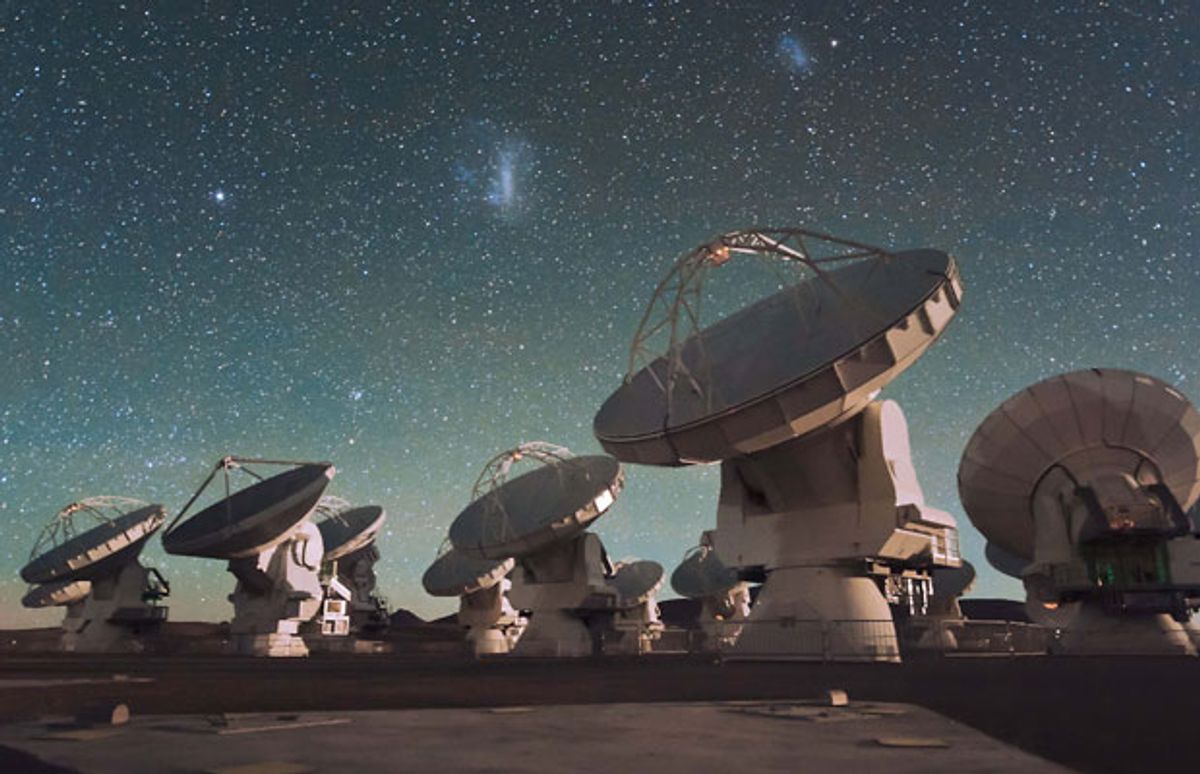The Atacama Large Millimeter/submillimeter Array (ALMA), an ambitious US $1.4-billion telescope capable of peering back into the early universe, made its official debut this week with an inauguration ceremony on Wednesday.
ALMA’s inauguration date is somewhat arbitrary: The array’s first dishes have been making observations since September 2011 and, although all of ALMA’s antennas have now been built, the full complement of 66 likely won’t be in place until the end of the year. Indeed, ALMA, which has been in the works since the 1990s, seems almost an old friend already. You may have noticed that another piece of ALMA news made headlines this week: A study published inNature found that starburst galaxies—hyperactive dust-shrouded galaxies that churn out stars at hundreds of times the rate of galaxies like the Milky Way—were active a good billion times earlier than previously thought. Those observations were made with just 16 of the array's first antennas.
But it’s as good a time as any to celebrate the project and the spirit of international cooperation made necessary by the scale of today’s astronomy projects. ALMA’s telescopes are owned by three primary partners: the US National Radio Astronomy Observatory, the National Astronomical Observatory of Japan, and the European Southern Observatory.
Built atop the 16 400-foot Chajnantor Plateau in Chile’s Atacama Desert, ALMA is designed to be sensitive to millimeter and submillimeter light, a region of the spectrum that extends beyond the infrared into the radio. Light hitting the array’s 12-meter and 7-meter wide dishes is combined to create a virtual telescope that effectively spans the size of the array, using a computationally-intensive strategy called interferometry. Like the Very Large Array in New Mexico, ALMA’s dishes can be moved to alter the “synthetic aperture.” In this case, special-designed transporter trucks are used. A more widely-spaced array allows researchers to make high-resolution observations of small patches of sky, while a tight arrangement allows the telescopes a wider field of view.
One of the best treatments of the ALMA this week comes from an aptly titled feature called “The Patchwork Array” by Eric Hand at Nature. Hand dives into not only the technology behind the telescope and what’s been learned so far, but also the cultural and political challenges of pulling the array together. He quotes Ethan Schreier, the president of NRAO’s operator, the Associated Universities Incorporated (AUI), as saying “I think it's the largest science project ever where nobody was in charge.”
One of the more sobering things he notes is how oversubscribed the facility already is. “Almost every data-taking moment has been allocated,” Hand says, and ALMA is already receiving six proposals for each slot. That leaves little space for ambitious departures like the deep-field surveys performed by the Hubble Space Telescope. That first deep field image—a 10-day exposure of a small patch of sky—was a lark. It was performed in 1995 on time allotted to the director of the Space Telescope Science Institute on what was supposed to be a relatively empty region of the sky. Instead, Hubble found thousands of distant galaxies, a watershed moment for many astronomers. Let's hope ALMA can do similarly great things.
Image: Xinhua/eyevine/Redux
Rachel Courtland, an unabashed astronomy aficionado, is a former senior associate editor at Spectrum. She now works in the editorial department at Nature. At Spectrum, she wrote about a variety of engineering efforts, including the quest for energy-producing fusion at the National Ignition Facility and the hunt for dark matter using an ultraquiet radio receiver. In 2014, she received a Neal Award for her feature on shrinking transistors and how the semiconductor industry talks about the challenge.



